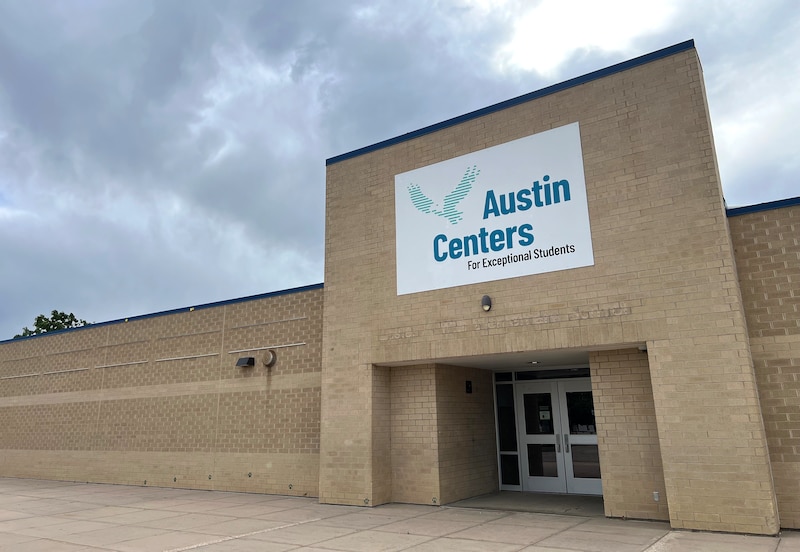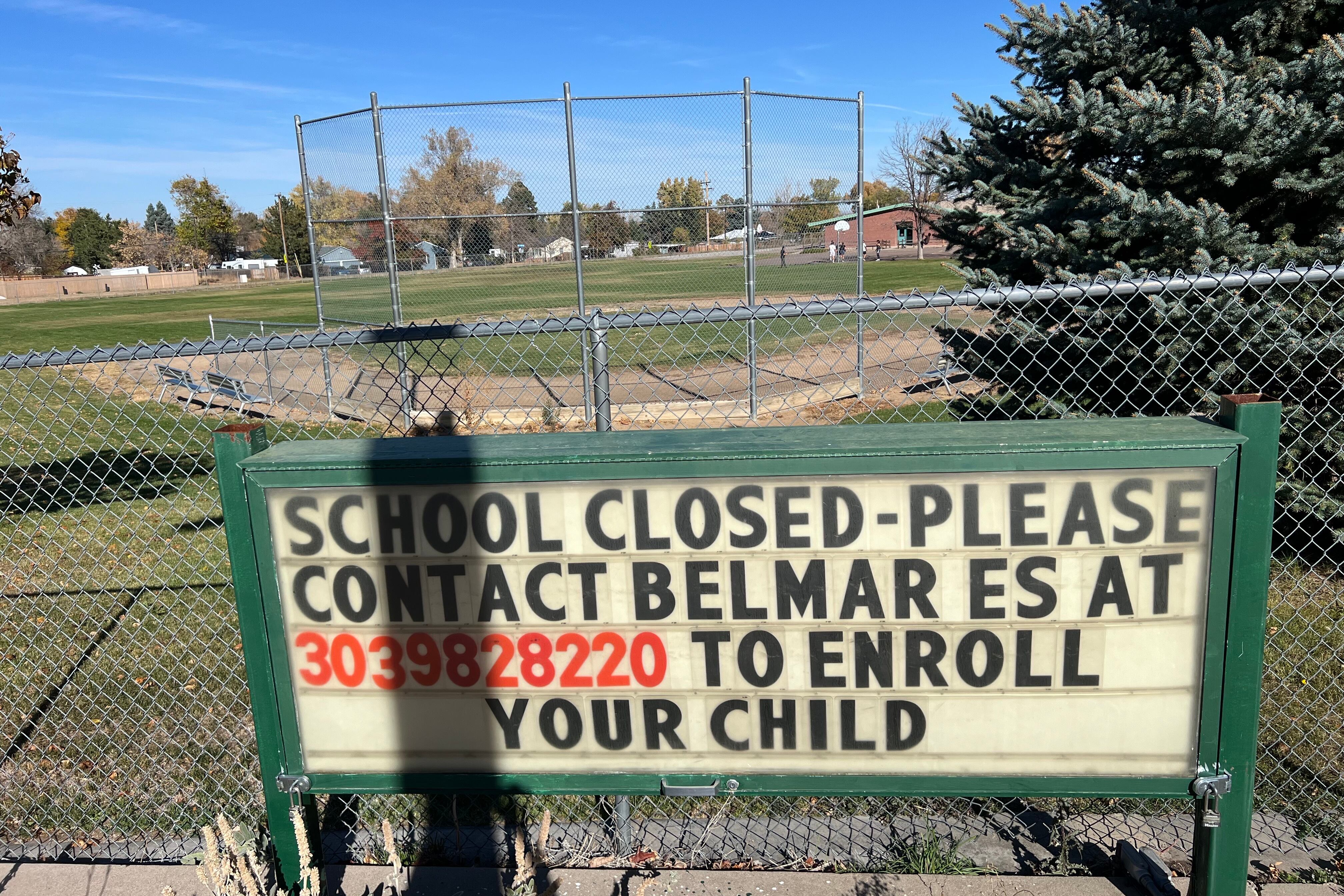Sign up for Chalkbeat Colorado’s free daily newsletter to get the latest reporting from us, plus curated news from other Colorado outlets, delivered to your inbox.
Construction workers in hardhats and safety vests bustled around the 7,000-square-foot Loveland building, installing fixtures and painting. It was late October, and they had two months to go before the grand opening.
Soon, the former Thompson School District preschool would become “The Landing,” the first shelter for homeless youth in northern Colorado. Leaders of the effort say the state-of-the-art-building will give young people ages 15 to 20 a safe place to live and receive services while they get their lives back on track.
The $9 million project is just one example of how Colorado school districts are repurposing shuttered schools. Often, such facilities keep serving students in some fashion — becoming child care centers, career education programs, or private or charter schools. In some cases, they are transformed into housing or nonprofit hubs.
Finding the right use for shuttered schools is a timely debate as enrollment declines in districts around Colorado and education officials face tough decisions about when to cut bait on underused buildings.
Colorado’s school-age population peaked around 2019 and has been decreasing ever since, according to State Demographer Elizabeth Garner. The declines will likely continue through 2029. At that point, the population is forecast to start increasing, reaching 2019 levels in 2036.
Garner said individual counties will reach their school-age population peaks and troughs at different times.
Enrollment in Colorado’s largest district, 90,000-student Denver Public Schools, also peaked in 2019 before steadily declining. Enrollment has bumped up the past two years due to an influx of migrant students, but district officials said it’s not enough to reverse the downward trend. They predict Denver’s enrollment will fall another 8% — or about 6,300 students — by 2028.
Denver closed three small schools at the end of the 2022-23 school year and is planning more closures this spring.
The state’s second-largest district, 76,000-student Jeffco Public Schools, has also experienced sharp enrollment declines over the past decade. Jeffco has closed 21 schools since 2021, though the district pledged to pause on any more closures for the next three years.
Aurora Public Schools, which now serves about 39,000 students, experienced a drop in enrollment of more than 10% between 2015-16 and 2020-21, which led to it closing eight schools by the end of 2022-23 on the west side of the district. Aurora always expected their student count to increase on the east side with rapid new development. But in the last year or two, some schools on the west side are also seeing enrollment increases with the arrival of new immigrant families.
Jeffco has the most empty school buildings
Jeffco Public Schools has a bumper crop of empty school buildings — and a dedicated website to track what the district is doing with those buildings.
The website lists 21 school buildings in six cities throughout Jefferson County. Two buildings, the former Allendale and Zerger elementary schools, are being sold to developers, who would raze the buildings and build housing on the sites.
Jeffco officials, like those in other districts, face a tricky balancing act when deciding what to do with closed schools. They don’t want to sell buildings they may need to reopen if enrollment jumps, but they don’t want to sink money into mothballed buildings that sit vacant for years and hurt the vibrancy of neighborhoods.
The relatively low purchase price for Zerger, in Westminster, raised some eyebrows among Jeffco school board members. If all goes to plan, the district would be paid $1.26 million for the site, or $45,000 per housing lot for a minimum of 28 lots.
“I will admit that when I saw the Zerger offer … my feeling was, ‘Oh no. I don’t want to sell any of our properties that low,’” school board President Mary Parker said at a board meeting in June. “But then there’s also the considerations of the cost to maintain the buildings, however long, and the community feelings about leaving the properties there.”
The Allendale building, in Arvada, fetched a higher price: $3.56 million, or $62,500 per housing lot for a minimum of 57 lots. But the school district won’t get paid right away. The contracts give the developers a year to get the proper building permissions before the sale goes through.
Contract negotiations are underway on three more empty Jeffco elementary schools: Thomson in Arvada, and Vivian and Glennon Heights in Lakewood. District leaders expect two of the three buildings will likely be reused instead of demolished.
Greg Avedikian, the district’s operations and strategy project manager, said the community has had “mixed reactions” to the district selling vacant buildings. But he emphasized that the money Jeffco earns will go into a fund to maintain and improve the buildings that are still in use.
“If we can find a source of revenue from buildings we don’t have a justifiable need for, it’s absolutely the right thing to do for the students we’re serving now,” he said.

Two more vacant elementary schools, Emory in Lakewood and Parr in Arvada, may be sold to the cities in which they’re located. The school district’s process is to offer the buildings to the cities first — and if the cities pass, to put them up for sale more generally. Lakewood initially passed on another school site at Vivian. But after neighbors said they wanted it to become a park, Avedikian said the district is working with the city on a possible solution.
Eleven of the 21 buildings have not yet been put up for sale or reuse. District spokesperson Kimberly Mahugh said Jeffco is moving through the list “methodically and thoughtfully.”
Two other former elementary schools are still serving students. The former Campbell Elementary is now a district preschool. And the former Witt Elementary has been leased to a private organization called Austin Centers for Exceptional Students that contracts with school districts to serve students with intense mental and behavioral health needs or disabilities.
Ownership of the former Sheridan Green Elementary automatically reverted to the city of Westminster when the school closed in the spring of 2023, thanks to a unique clause in the deed, which was drawn up many decades ago, Avedikian said.

How Denver and Aurora are using closed school buildings
Of the three Denver schools that closed in 2023, two were in shared buildings that are still occupied by other schools. The third, Fairview Elementary, was quickly repurposed by the district. It’s now home to a special education program called Next Steps by Chancelight.
Over the years, Denver Public Schools has leased or sold other vacant school buildings. In 2021, the district leased the long-empty Rosedale Elementary school building to the Catholic Archdiocese of Denver. It’s now home to St. John Paul the Great High School.
And DPS is in talks with the city of Denver about using the vacant Remington school building as an emergency shelter for migrants. Remington most recently housed a charter middle school, Rocky Mountain Prep Sunnyside, that has since moved to another building.
In Aurora, six of eight vacated buildings are still serving as schools. During the pandemic, some served as remote learning centers for students who needed to access the internet.
Since then, two buildings were turned into magnet schools, one was converted into a new preschool, and two are housing alternative school programs. One small elementary school, Lynn Knoll, which had a capacity of 250 students, was demolished and rebuilt into Del Mar Academy, which is now serving almost 1,000 students in preschool through eighth grade.
In all of those cases, district leaders said they worked internally to identify how the district should use those buildings.
But in the case of the now-closed Paris Elementary, the district didn’t identify a need, so asked the community for input and then opened a request for proposals. After receiving about five proposals, the board voted in June to lease the building to local nonprofits that formed into the All Black Collective or ABC Collective. The collective is running a community center in the building with programming for students and families.
“We’re ideally looking to find alignment between district needs and community needs,” said Christie Imholt, executive director of policy and strategy for Aurora schools.
The Aurora district is still evaluating what to do with the former Sixth Avenue Elementary and expects to make a decision this year.
New youth shelter in Thompson will serve region
The 15,000-student Thompson school district has closed six school sites in the last six years. Over the same period, it’s lost more than 1,200 students, or an 8% decline.
Four of the closed schools are still owned by the district, including one converted to an early childhood center, one to a YMCA preschool, one that now houses the district’s alternative high school and career programs, and the one that will soon be a youth shelter.

The district sold a fifth building to a Christian school. The sixth building, a closed elementary school next to a busy road, is on the market.
“There are strategic sales, but it’s not as common that we end up selling our buildings,” said Kristen Battige, the district’s director of facilities. “Because while we have declining enrollment right now, we also need to look beyond that.”
The idea for Loveland’s new youth shelter started percolating at a May 2022 meeting of advocates and elected officials about youth homelessness in Larimer County.
Nicole Armstrong, executive director of Matthews House, a Fort Collins nonprofit, realized during the event that although her organization provided some housing support for homeless youth it was essentially dabbling in that area.
“I sat in that space and committed to being part of a solution,” she said.
A month later, Armstrong connected with a top administrator from Thompson to tour district buildings that might work for a youth shelter. The former Monroe Early Childhood Center, nestled in one corner of a soon-to-be closed elementary campus, was perfect.
Battige, Thompson’s facilities director, said the district offered the building — worth about $1.9 million — to the project, though it maintains ownership.
“We know if kids don’t have their basic needs met, they’re not able to learn successfully,” she said. “While operating a youth shelter is not what we do … we have the building, the infrastructure, the knowledge around construction.”
Armstrong said the state’s only youth shelters are in Boulder, Denver, and Colorado Springs – usually too long of a trek for northern Colorado youth. That’s why many teens facing housing instability end up couch-surfing.
“Often they’re maybe staying with someone in exchange for sex or drugs or other things,” she said.
Matthews House will run The Landing when it opens in January. The shelter will have the capacity to serve 20 youth overnight, with those under 18 in one wing and those 18 and over in the other.
The space will be filled with lots of natural light, social spaces, and cozy nooks, and sightlines that extend from the front doors to the back of the building so youth don’t feel hemmed in. The shelter will offer hot meals, laundry facilities, a health clinic, mental health support, and a daytime drop-in space.
The idea, said Armstrong, is to ensure “it’s a space that feels safe, and not just safe to anyone walking in there, but people specifically who have experienced trauma.”
Ann Schimke is a senior reporter at Chalkbeat, covering early childhood issues and early literacy. Contact Ann at aschimke@chalkbeat.org.
Melanie Asmar is the bureau chief for Chalkbeat Colorado. Contact Melanie at masmar@chalkbeat.org.
Yesenia Robles is a reporter for Chalkbeat Colorado covering K-12 school districts and multilingual education. Contact Yesenia at yrobles@chalkbeat.org.







